
 Italian Regia Marina Ironclads, 1862-1890s: Regina Maria Pia, San Martino, Castelfidardo, Ancona
Italian Regia Marina Ironclads, 1862-1890s: Regina Maria Pia, San Martino, Castelfidardo, Ancona
Development history
The Regina Maria Pia class was a group of four ironclads built for the Regia Marina in the 1860s. The class comprised four ships, Regina Maria Pia, San Martino, Castelfidardo, and Ancona. They were built by French shipyards, as Italian yards at the time could not meet the demand of the ambitious Italian naval plan. They resembled French ironclads of the time such as Courronne, with twenty-six muzzle loading guns. All four ships were present at the Battle of Lissa in 1866, freshly commissioned. Regina Maria Pia was found in the area attacked by Tegetthoff and badly damaged in combat, while the others arrived too late. Afterwards they had long careers, modernized in the late 1880s and used afterwards as training ships. Regina Maria Pia, San Martino, and Ancona were decommissioned in 1903–1904 and Castelfidardo in 1910.
The Austro-Italian ironclad arms race
⚙ The Austro-Italian naval Arms Race prior to Lissa (1864) | |
 Regia Marina Regia Marina |  KuK Kriegsmarine KuK Kriegsmarine |
|
Formidabile class 1860 Principe di Carignano class 1861 Re d'Italia class 1861 Regina Maria Pia class (1862) Roma class (1863) Affondatore (1863) Principe Amedeo class (ordered 1865) |
Drache class (1860) Kaiser Max class (1861) Erzherzog Ferdinand Max class (1863) |
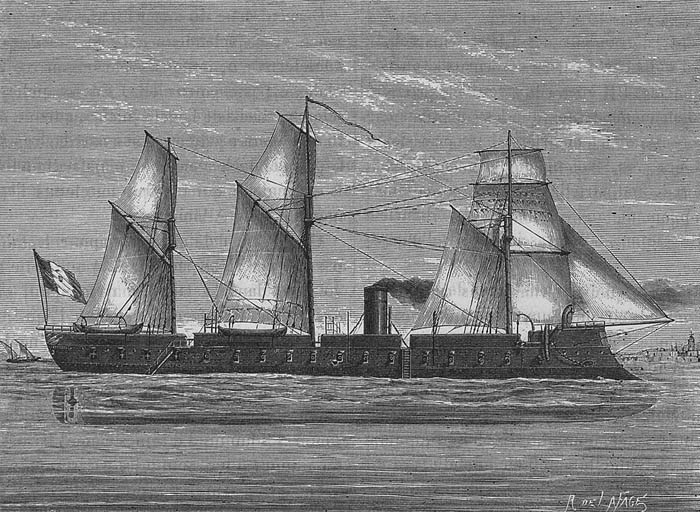
They started in the same move following unification of Italy in 1861, with a massive construction program setup to defeat the Austrian Navy, main rival, and controlling Venice. Italian shipyards bing unable to procure all the new ironclads asked for, foreign ship builders were contacted (France, Britain and the US). In 1862, this was the turn for the four Regina Maria Pia class, all from French shipyards. There was a delegation there, supervised by Vice Admiral Carlo Pellion di Persano acting as Navy Minister at the time (later at the head of the fleet). The design was French, and they were closely based on the Couronne, launched 1861, but with a more pronounced ram comparable to the Magenta class, 3 m (9.8 ft) long.
Design of the class
Hull and general design
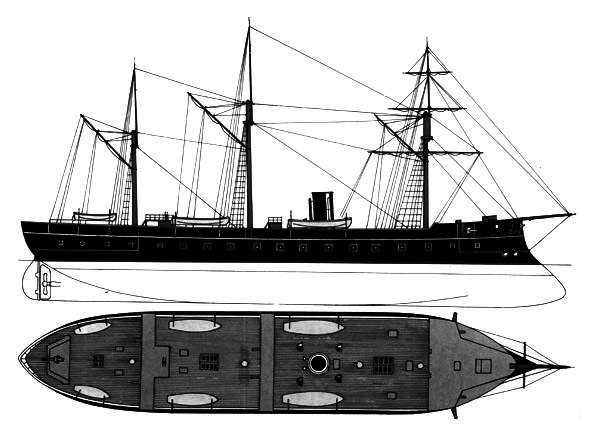
The ships of the Regina Maria Pia class diverged in displacement between construction sites:
-Regina Maria Pia and San Martino came from the same shipyard, Société Nouvelle des Forges et Chantiers de la Méditerranée, abbreviated as FCM, and identical in size: 75.48 meters (247.6 ft) long between perpendiculars and 81.2 m (266 ft) long overall, 15.24 m (50.0 ft) in beaml for an average draft of 6.35 m (20.8 ft). They displaced 4,201 long tons (4,268 t) normal load, 4,527 long tons (4,600 t) when fully loaded.
-Castelfidardo and Ancona, came from different shipyards, Gouin et Guibert in Nantes (Atl. Coast) and and Arman Brothers in Bordeaux (Gironde Est.). Castelfidardo displaced 4,191 long tons (4,258 t) normal, 4,527 long tons (4,600 t) fully loaded and Ancona was declared at 4,157 long tons (4,224 t) and 4,619 long tons (4,693 t) fully loaded but they were supposed to have the same dimensions.
All had iron hulls with a pronounced ram below the waterline.
This was a relatively large hull/lenght ratio, customary at the time. They had well rounded bottoms, a rectangular central section, fine entries and ends. The ranged from 480 to 485 officers and ratings. The original schooner-rigging was used for long range cruise and backup, and comparable to the Couronne with three main mast and a bosprit, three stage sail plan. After refit and modernization, this rigging was cut down and reduced to a barque rig. The last refit saw the rig removed and replaced by two thick military masts with fighting tops.
Protection
They all had the same general scheme, with an iron belt plating 4.75 inches (121 mm) thick for the whole waterline length over approx. 4 meters (12 ft) whereas the battery deck had 4.3 in (109 mm) wrought iron plating. This was much better than the Couronne which had 3.2 inches battery deck and 4-inches main belt plating. Somes sources states that however Castelfidardo and Ancona had a 110 mm (4.3 inches) iron belt.
Powerplant
Propulsion relied on a single-expansion, two-cylinder steam engine dricing a single four bladed bronze screw propeller, which was fixed (not removable to sail). The engine types is unknown and linked to their yard. Steam came from by six (FCM ships) or eight (The two others) coal burning boilers, rectangular and using fire-tubes. Here again, there were changes between yards. The boilers were then trunked into a single funnel amidships. Also it diverged between ship, the average output was 2,924 indicated horsepower (2,180 kW). But they all diverged on trials: Regina Maria Pia was the one rated for 2,924 shp, whereas San Martino obtained 2,620 shp, Castelfidardo 2,125 shp and Ancona 2,548 shp.
Top speed on trials of 12.96 knots (24.00 km/h; 14.91 mph) and most sources states 13 kts to round it up, but she was not the fastest, as this was Ancona at 13.7 knots. San Martino averaged 12.6 kts and Castelfidardo 12.1 knots.
They also had the same coal bunkerage capacity of 485 long tons (493 t). This allowed a 2,600 nautical miles (4,800 km; 3,000 mi) range at 10 knots (19 km/h; 12 mph) cruise speed. That was for all of them. Distinct figures are not known.
Armament
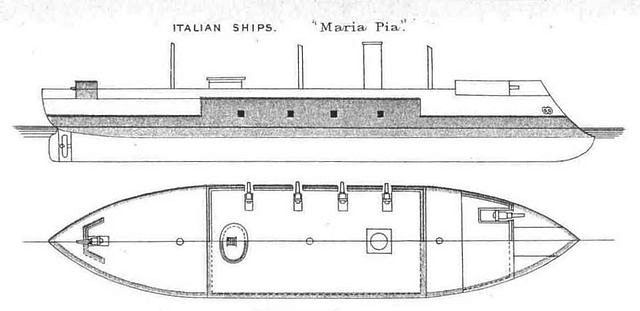
As broadside ironclads, initially their main battery was spread along the battery deck at a single level. They had however four 72-pounder smooth-bore 203 mm (8 in) muzzle-loading guns on deck, and twenty-two 32-pounder rifled 164 mm (6.5 in) muzzle loaders in the battery deck. Two of the 164 mm guns were placed in an armored bunker forward, the third was placed in a similar arrangement but at the stern. Regina Maria Pia and San Martino used 8-in/13 Armstrong 7ton MLR completed by 22 British 164mm/17 Palliser 5.12 ton MLR or 164/16 Palliser 3.54 ton MLR.
Castelfidardo and Ancona had the same main gun but one more (23) 164mm/17 Palliser 5.12/3.54 ton MLR.
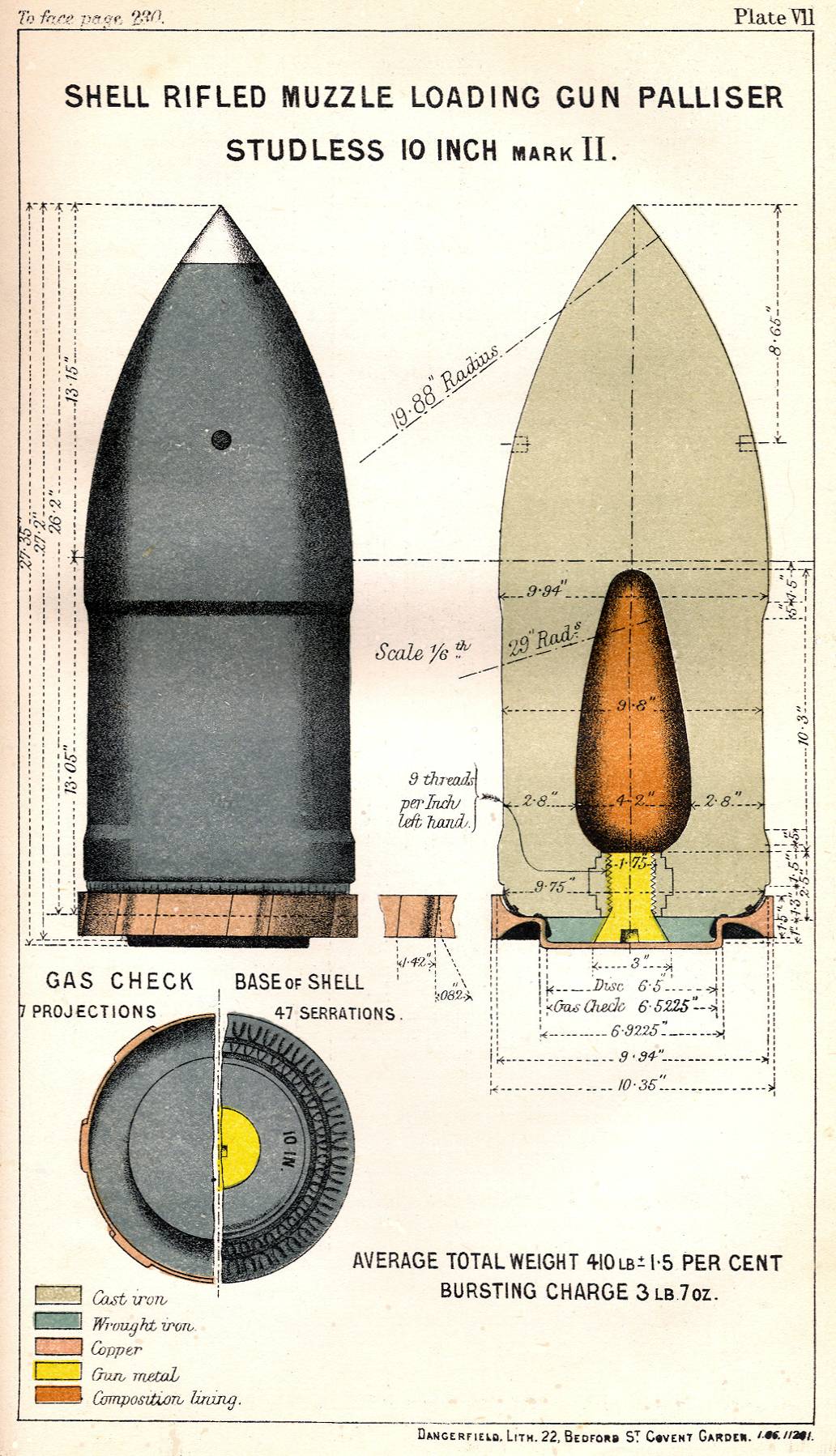
As a reminder, the Palliser shot was an early British armour-piercing artillery projectile intended to pierce the armour protection of warships. It was adopted with the Italian Navy also to defeat Austrian Ironclads.
1871 Revision: Casteldidardo and Ancona received in 1871 two 254/14 (10-inches) Armstrong 8.1 ton MLR No2 (other sources: two 220 mm (8.7 in) muzzle-loading guns, eight 8 in muzzle-loading guns) and they had also eight 203mm (8-inches)/13 Armstrong 7ton MLR.
1875 Revision:
In 1875, Regina Maria Pia and San Martino were rearmed with two 229mm (3.9 inches)/14 Armstrong 12.6 ton MLR, and nine 203mm (8-in)/13 Armstrong 7 ton MLR, same as before but one more.
1880s Revisions:
The same rearmament was done in 1880 for Castelfidardo and Ancona.
1884-85 Revisions:
In 1884: Regina Maria Pia and San Martino: eight 152 mm/33 (6 in) model 1883 Armstrong quick-firing (QF) guns, five 120 mm/24 (4.7 in) Armstrong QF 1.38 ton BLR guns, four 57mm/40 (2.2 in) Hotchkiss QF guns, eight 37 mm/20 (1.5 in) Hotchkiss revolver cannon. They had now a central armoured casemate (same armour as before), with large gun to fire ahead and astern, two guns forward, one astern. The armour for the end guns howver was removed.
In 1884, Castelfidardo also received these light guns, but with a sixth 4.7 in gun.
In 1884 Ancona was re-armed the same but just with two 37 mm revolver cannon.
All four ships had now three torpedo tubes but Castelfidardo (two tubes), all firing 350 mm (13 inches) Whitehead torpedoes in a one bow, two beam arrangement.
1900 Revision (Casteflidardo as TS)
When Castelfidardo was re-rated and modified as a training ship, she was disarmed, only sample guns installed for instruction: One 76mm/40 Armstrong, one 75mm/21 Uchatius 29cwt BL No1 gun and four 57mm/43 Nordenfelt guns, a single 47mm/40 (c.o.) type, and two five-barreled 37mm/20 Hotchkiss as well as two of the new 450 mm (18 inches) torpedo tubes, at the beam.
⚙ specifications |
|
| Displacement | 3,446 long tons normal, 3,912 long tons (3,975 t) FL |
| Dimensions | 72.89 x 15.10 x 7.18m (239 ft 2 in x 49 ft 6 in x 23 ft 7 in) |
| Propulsion | 1 shaft marine steam engine, 6 fire-tube boilers 1,968 ihp (1,468 kW) |
| Speed | 10.4 knots (19.3 km/h; 12.0 mph) |
| Range | 1,200 nmi (2,200 km) at 10 kn (19 km/h; 12 mph) |
| Armament | 10 × 203 mm (8 in), 12 × 164 mm (6 in) guns |
| Protection | Belt armor 121 mm (4.75 in) |
| Crew | 572 |
General Assessment
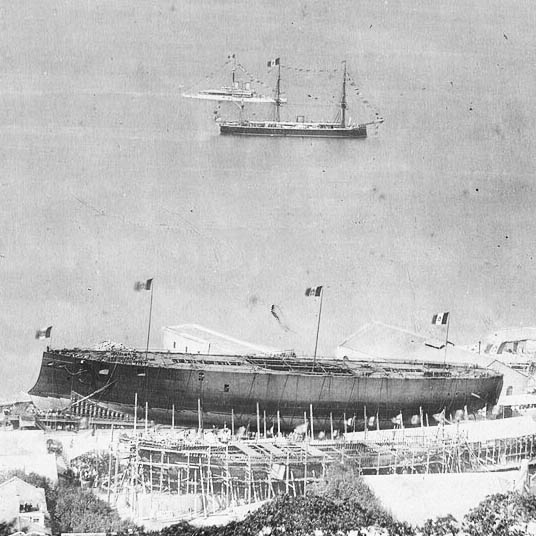
Regina Maria Pia (right background) at the launch for the ironclad Italia in 1880. The other ships present are the Italian Principe Amedeo (behind Regina Maria Pia) and the British HMS Monarch and Thunderer (center background)
All four ships were essentially French ships with British Armament, latest and best on offer with armoure piercing shells. They entered service just in time as the Third Italian War of Independence broke out. Soon the young Regia Marina, which had little time to train, was prepared against the Austrian Navy in 1866. On paprt it was largely superior, but this was done at a huge cost. Persano became commander of the Italian fleet but was at first perhaps too cautious with the fleet he built. After much political pressure he started an offensive operation in order to occupy the island of Lissa. This conducted Wilhelm von Tegetthoff to attack but of all four, only Regina Maria Pia was present on the Island’s side exposed to the Austrian wedge and was badly damaged and burned, but survived. San Martino and Castelfidardo arrived a bit late and were not engaged as much, and less seriously damaged. Ancona was even further and received few blows, only denting some of her iron plates. It’s difficult to proved their performances in that occurence, as they failed to be together in time, performed relatively poorly and missed an opportunity to ram their opponents.
After the war the naval budget was cut back so much the ironclad squadron mobilized to attack the port of Civitavecchia in September 1870 (last war of Italian unification) was a shadow of its former self. The Regina Maria Pias however received most attention and returned to active service, seeing exercises with main fleet as well as over colonies. In fact instead of being scrapped, their iron hull stood well the test of time and they were modernized in the late 1880s, albeit way too slow at that stage. They were used as training ships. Regina Maria Pia, Ancona, and San Martino were stricken in 1903–1904, Castelfidardo becoming a training ship in 1900-1910, which was overall a better career than most of their contemporaries, but Affondatore, still around in WW1.
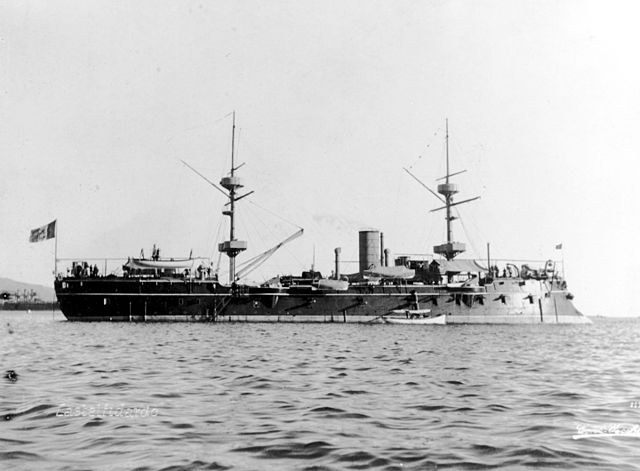
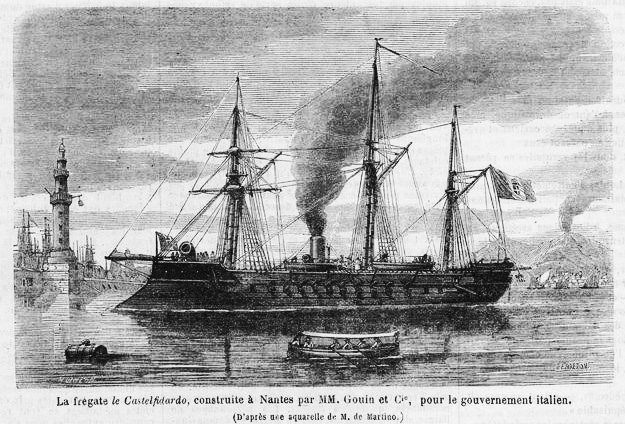
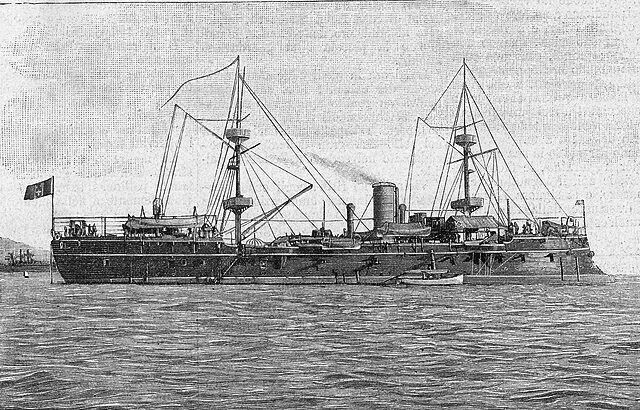

Read More/Src
Books
Dupont, Paul (ed.). “Notes sur La Marine Et Les Ports Militaires de L’Italie” [Notes on the Navy and Military Ports of Italy]. La Revue Maritime et Coloniale [The Naval and Colonial Review] (in French). Paris: Imprimerie Administrative de Paul Dupont. XXXII: 415–430.
Fitzgerald, Charles (1897). Life of Vice-Admiral Sir George Tryon, K.C.B. London: William Blackwood and Sons.
Fraccaroli, Aldo (1979). “Italy”. In Gardiner, Robert (ed.). Conway’s All the World’s Fighting Ships 1860–1905. London: Conway Maritime Press. pp. 334–359. ISBN 978-0-85177-133-5.
Garbett, H., ed. (1895). “Naval and Military Notes”. Journal of the Royal United Service Institution. London: J. J. Keliher & Co. XXXIX (203): 81–110. OCLC 8007941.
Greene, Jack; Massignani, Alessandro (1998). Ironclads at War: The Origin and Development of the Armored Warship, 1854–1891. Pennsylvania: Da Capo Press. ISBN 978-0-938289-58-6.
Ordovini, Aldo F.; Petronio, Fulvio & Sullivan, David M. (December 2014). “Capital Ships of the Royal Italian Navy, 1860–1918: Part I: The Formidabile, Principe di Carignano, Re d’Italia, Regina Maria Pia, Affondatore, Roma and Principe Amedeo Classes”. Warship International. Vol. 51, no. 4. pp. 323–360. ISSN 0043-0374.
Sondhaus, Lawrence (1994). The Naval Policy of Austria-Hungary, 1867–1918. West Lafayette: Purdue University Press. ISBN 978-1-55753-034-9.
Wilson, Herbert Wrigley (1896). Ironclads in Action: A Sketch of Naval Warfare from 1855 to 1895. London: S. Low, Marston and Company. OCLC 1111061.
Links
https://www.marina.difesa.it/noi-siamo-la-marina/mezzi/mezzi-storici/Pagine/PQRS/regina_maria_pia.aspx
https://www.navypedia.org/ships/italy/it_bb_regina_maria_pia.htm
https://en.wikipedia.org/wiki/Regina_Maria_Pia-class_ironclad
https://it.wikipedia.org/wiki/Classe_Regina_Maria_Pia
 Regina Maria Pia
Regina Maria Pia
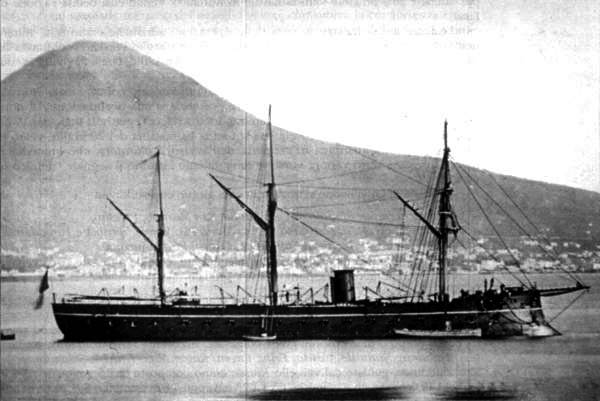
Regina Maria Pia was laid down at FCM of Toulon, Mediterranean, on 22 July 1862, launched on 28 April 1863, completed on 17 April 1864 and by June 1866, mobilized with the declaration of war on Austria. Under command of Admiral Carlo Pellion di Persano, too cautious and stating he wanted to wait for the british-built ironclad ram Affondatore completing in britain as his flagship and “secret weapon”. His inaction weakened morale and infuriated many of his officers which went over his head to the Government, which in return pressured him to act.
Meanwhile, RADM Wilhelm von Tegetthoff moved to Ancona on June 27, but failed to draw out the Italians which fleet was still unprepared, missing for some their entire armament, also coming from Britain, missed ammunition, training and had machinery troubles.
Regina Maria Pia was one of the rare fit for action at the time as her sisters, so they were placed at the core of the fleet to attack Tegetthoff’s fleet. Persano had his council of war on Principe di Carignano and planned a sortie against the Austrians, which in between withdrew. The new Minister of the Navy, Agostino Depretis, urged Persano to draw the Austrian out by attempting to seize the strategic island of Lissa. This was also to restore hope and morale after the defeat at Custoza. On 7 July, Persano left Ancona for a first sortie, but did not ventered to lissa, missed the Austrians and was back on the 13th.
On the 16th his fleet was again out of Ancona and this time escorted troophips for Lissa, arriving on the 18th. It was planned to bombard the defenses around the islands then land some 3,000 soldiers. Soon informed, the Austrian Navy sent the fleet and Persano divided the fleet armound the Island. Regina Maria Pia was in 3rd Division under command of Captain Augusto Riboty, with the Terribile, Formidabile, and Re di Portogallo, as well as the coastal defense ship Varese. The Austrian fortresses proved a touger nut to crack than anticipated and the landing was recalled. Persano concentrated on Vis next, but again with no avail as the defenses held firm.
The next morning, he sent four ironclads to force the harbor defenses at Vis. Meanwhile Regina Maria Pia her her division, plus the rest of the fleet would continue bombarding outer fortifications, but it all ended up in failure, with a third attempt planned for the next day. This day on the 20th, the dispatch boat (scout) Esploratore (well named as it means “scout”) arrived with news of the incoming Tegetthoff’s fleet. Persano’s fleet ordered his dispersed ships to gather immediately with Vacca’s division being placed first in line abreast formation, then in line ahead formation with Regina Maria Pia initially the last in line, Varese behind her.
As the two fleets were approaching each others but not yet in immediate collision course, Persano left his flagship Re d’Italia to be transferred to Affondatore, not notifying the rest of the fleet, which all this time waited from signals coming from Re d’Italia, that never came. Re d’Italia being stopped for the manoeuver opened a gap which Tegetthoff exploited by wedging his formation. He manage to pass right through Vacca’s and Persano’s divisions, initiating a melee with a “ramming fest” in the first pass, missed, but then turned back toward Persano. His entire fleet shelled Re d’Italia, San Martino, and Palestro. Re d’Italia and Palestro were badly mauled and burned. Meanwhile Riboty on Regina Maria Pia took the lead of his division to attack Anton von Petz’s division, composed of seemingly easy preys, wooden steam frigates. Regina Maria Pia however when manoeuvering t take advantage of its ram, collided with San Martino.
Palestro withdrew, and with Persano’s division in disarray, Tegetthoff turned against Riboty’s division. Persano meanwhile broke off to consolidate his forces but other ships were slow to rally and low on coal, until the whole Italian fleet withdrew followed by the Austrians until night fell. The Italian fleet was back at Ancona and damage assessment reported Regina Maria Pia relatively unscaved, with one iron plate destroyed, another with a buried steel shot, so her protection held on but as the Austrians lobbed incendiaries, she was badly burned, to the point of nearly reaching her powder magazine. During the battle she engaged SMS Kaiser and ironclad Prinz Eugen nevertheless, scoring hits. Vacca became the new admiral of the fleet as Persano was sacked. Ordered to attack Pola, the war ended as his ships were being repaired and prepared.
Regina Maria Pia was part of the main fleet but also served in the colonial empire. She did not took part in the planned attack of Civitavecchia in September 1870, with her conscript sailors sent home. In 1866-67, she was rebuilt as central battery ship with an armored casemate recycling her belt armour, and new armament. By October 1871, she was based in La Spezia with her sisters Castelfidardo and San Martino but also Affondatore, and Roma. In May 1876 Salonika Incident she was sent to Tessaloniki as both French and German consuls were murdered by the population. Regina Maria Pia was also present at the launching ceremony of the new ironclad Italia on 29 September 1880. She was later modernized and became an harbor guard ship in La Spezia until stricken in 1904, BU.
 San Martino
San Martino

San Martino’s keel was laid down at the FCM, La Seyne, Toulon like her sister on 22 July 1862, launched on 21 September 1863, completed on 9 November 1864. She was stationed at Ancona on 27 June when Tegetthoff’s fleet arrrived to lure out the Italians, and was unlike many of her sisters, in shape to depart, but Persano refused to engage the four sisters. Castelfidardo, Regina Maria Pia, and Principe di Carignano nevertheless were the most pressed for action.
On 16 July, Persano left Ancona for Lissa, with a plan to size the city by a bombardmùent followed by a landing. However he spread his ships while making several daily attemps and on the 20th, his divisions were all separated when the Esploratore reported the imminent arrival of Tegetthoff. Admiral Giovanni Vacca’s 1st Division was still three miles northeast and the rest to the west. Re d’Italia, San Martino, and Palestro were in the initial Persano’s division and came under heavy fire. San Martino initially targeted the Austrian 2nd Division’s unarmoured ships, but tried to aid Re d’Italia, but arrived too late, witnessing her ramming by Erzherzog Ferdinand Max. At that point, Tegetthoff ordered his crew to lower boats and pick survivors, but renounced as San Martino fast approach and ordered instead the aviso Kaiserin Elizabeth, also soon under fire and abandoning the rescue.
San Martino while manoeuvering, collided with her sister Regina Maria Pia, her ram bow twisted and hull leaking. Persano broke off the engagement to consolidate but too late and the wholme fleet disengaged and withdrew, arriving at night at Ancona. San Martino was one of the most damaged, her side armor hit many times but only penetrated by single shell, stopped by the timber backing beyonf the plating. She received incendiary shells and was set on fire twice, but her better trained crew managed to extinguish it and control the damage.
The rest of her career was similar to her sister, she served with the fleet, in the colonial empire, and postwar was laid up until rebuilt like her sisters as a central battery ship, with a new armament. She was kept in the same division as her sisters in October 1871, at La Spezia. In August 1873, she visited Barcelona and to Valencia in September.
On 10 June 1887, she took part in the annual fleet maneuvers in the “attacking squadron” with Ancona and Duilio, and the cruiser Giovanni Bausan in a scenario of attack on the Strait of Messina and was present during the naval parade on front of King Umberto I. She took part in the annual 1888 fleet maneuvers with Lepanto, Italia, Duilio, Enrico Dandolo, in close-order drills and an attack on La Spezia. 1888-1890 saw multiple modernizations. In 1894 she was in the Third Division with the cruiser Liguria and torpedo cruiser Confienza. By 14 October she was in the Genoa naval review for the launching ceremony of the ironclad Re Umberto over three days. She was sent back to La Spezia until stricken in 1903, BU.
 Castelfidardo
Castelfidardo
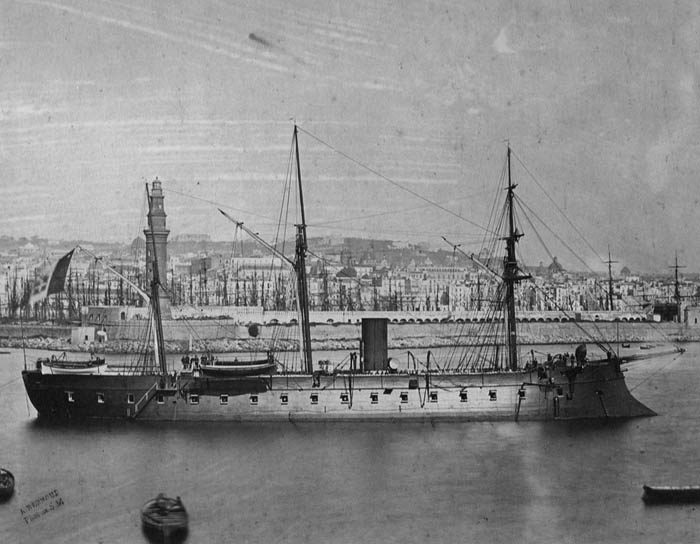
Castelfidardo was laid down on 27 July 1862 at Gouin et Guibert (Nantes, St. Nazaire, WCoast FR), launched on 1 August 1863, completed in May 1864. She had little time training until June 1866 as the war commenced. At Lissa, she initially reported engine troubles, bu they were repaired soon before the battle began.
She was in Vacca’s division, which turned Principe di Carignano and Castelfidardo to port, away from the Austrian ships but briefly engageed the rear Austrian wooden ships until driven off by heavy fire from three steam frigates using incendiary shells.
Castelfidardo, Principe di Carignano and Varese engaged Kaiser, the “wooden ironclad”, which was damaged and withdrew. When Persano broke off, refused to counter-attack leading to a general withdrawal, Castelfidardo arrived at Ancona relatively unscathed. Only the Captain’s cabin burnt.
Postwar amidst naval budget she was laid up, crew disbanded but after 1866 she was rebuilt like her sister as a central battery ship, and joined in La Spezia, Regina Maria Pia and San Martino, Affondatore, and Roma. She had a new upgrade in 1880. She took part in the annual fleet maneuvers of 1885, as part of “Eastern Squadron” with Principe Amedeo, Amerigo Vespucci, defending against the “Western Squadron” in a mock Franco-Italian war off Sardinia. On 10 June she took part in the annual fleet maneuvers again in the “defending squadron” with Enrico Dandolo, Palestro, and Affondatore, Dogali in defence of the Strait of Messina, followed by a fleet review for the King.
In 1895, Castelfidardo became harbor guard ship in La Maddalena and in 1899, assigned to the 2nd Division with Affondatore and Sicilia, Partenope and Urania. In 1900 she was conveted as a torpedo training ship (see above) and was stricken in 1910, BU, the last of her class.
 Ancona
Ancona
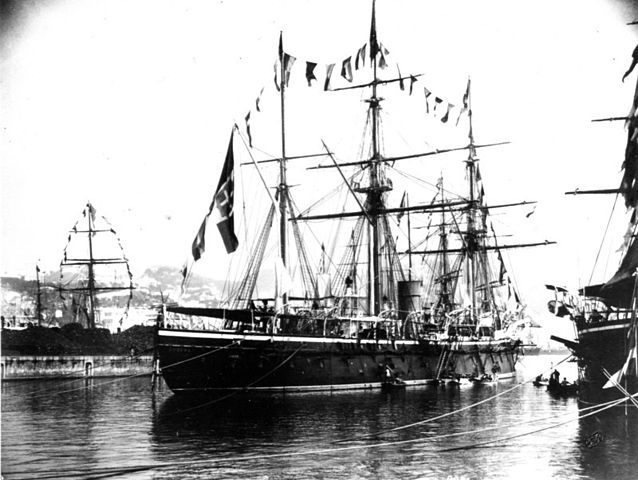
Ancona was laid down at Arman Brothers shipyard, Bordeaux, Western France on 11 August 1862, the last launched on 17 October 1864, completed in April 1866. She barely arrived when in June was was declared against Austria. Prior to the Battle of Lissa on 17-19 July, Ancona was assigned to the 1st Division (Admiral Giovanni Vacca) with her sister Castelfidardo and Principe di Carignano, flagship. Ordered to bombard Austrian fortresses, Vacca reported his inadequate guns elevation to hit the tall fortifications ans the attack failed. Next, efforts concentrated o the port of Vis. Formidabile entered the port the following day, engaged the Madonna battery supported by Ancona. The confined waters however only allowed Formidabile to operate, but with poor results.
Another attempt was done on the 20th with Vacca sailing to the north-east, until Tegetthoff’s approach was reported. Vacca was recalled to be first in line abreast/line ahead formation with Ancona third ship in line. Vacca turned his division to port durng the melee, when Persano’s division was under heavy fire, but failed to sink the rear Austrian wooden ships under Anton von Petz, repelled. At the time Re D’Italia was rammed by Erzherzog Ferdinand Max, Ancona ablaze by Austrian shells, still the fires were mastered. Ancona and Varese attempted another attack on von Petz but they collided and became entangled. When their crews freed them up, Von petz was away. Persano then broke off to consolidate and later started to withdraw, the whole fleet heading back to Ancona. The namesake ironclad had been hit many times and some shells disloged iron plates, one penetrated in a gun port and exploded insde the battery, causing mayheme. So repairs were more extensive.
Postwar she had the same as her sister. Laid up, then rebuit with a central armored casemate, but stationed in Genoa, not in La Spezia.
In 1873, she was assigned to the 1st Division, Permanent Squadron with Roma and Conte Verde. She trained with the 2nd Division, and by 10 June 1887 took part in the annual fleet maneuvers as part of the “attacking squadron” with San Martino and Duilio, Giovanni Bausan on the Strait of Messina followed by a fleet review. On 1 October 1893, she was in Taranto along with Affondatore, Liguria, Etruria, and Umbria, Monzambano, Montebello, and Confienza and in 1894. She became afterwards a harbor guard ship in Taranto from 1895 until stricken in 1903, BU.

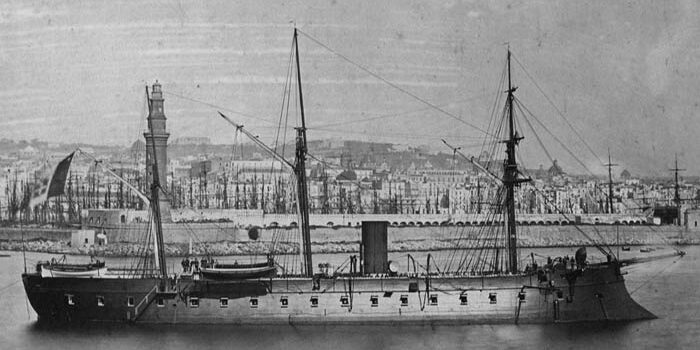
 Latest Facebook Entry -
Latest Facebook Entry -  X(Tweeter) Naval Encyclopedia's deck archive
X(Tweeter) Naval Encyclopedia's deck archive Instagram (@navalencyc)
Instagram (@navalencyc)





 French Navy
French Navy Royal Navy
Royal Navy Russian Navy
Russian Navy Armada Espanola
Armada Espanola Austrian Navy
Austrian Navy K.u.K. Kriegsmarine
K.u.K. Kriegsmarine Dansk Marine
Dansk Marine Nautiko Hellenon
Nautiko Hellenon Koninklije Marine 1870
Koninklije Marine 1870 Marinha do Brasil
Marinha do Brasil Osmanlı Donanması
Osmanlı Donanması Marina Do Peru
Marina Do Peru Marinha do Portugal
Marinha do Portugal Regia Marina 1870
Regia Marina 1870 Nihhon Kaigun 1870
Nihhon Kaigun 1870 Preußische Marine 1870
Preußische Marine 1870 Russkiy Flot 1870
Russkiy Flot 1870 Svenska marinen
Svenska marinen Søværnet
Søværnet Union Navy
Union Navy Confederate Navy
Confederate Navy Armada de Argentina
Armada de Argentina Imperial Chinese Navy
Imperial Chinese Navy Marinha do Portugal
Marinha do Portugal Mexico
Mexico Kaiserliche Marine
Kaiserliche Marine 1898 US Navy
1898 US Navy Sovietskiy Flot
Sovietskiy Flot Royal Canadian Navy
Royal Canadian Navy Royal Australian Navy
Royal Australian Navy RNZN Fleet
RNZN Fleet Chinese Navy 1937
Chinese Navy 1937 Kriegsmarine
Kriegsmarine Chilean Navy
Chilean Navy Danish Navy
Danish Navy Finnish Navy
Finnish Navy Hellenic Navy
Hellenic Navy Polish Navy
Polish Navy Romanian Navy
Romanian Navy Turkish Navy
Turkish Navy Royal Yugoslav Navy
Royal Yugoslav Navy Royal Thai Navy
Royal Thai Navy Minor Navies
Minor Navies Albania
Albania Austria
Austria Belgium
Belgium Columbia
Columbia Costa Rica
Costa Rica Cuba
Cuba Czechoslovakia
Czechoslovakia Dominican Republic
Dominican Republic Haiti
Haiti Hungary
Hungary Honduras
Honduras Estonia
Estonia Iceland
Iceland Eire
Eire Equador
Equador Iran
Iran Iraq
Iraq Latvia
Latvia Liberia
Liberia Lithuania
Lithuania Mandchukuo
Mandchukuo Morocco
Morocco Nicaragua
Nicaragua Persia
Persia San Salvador
San Salvador Sarawak
Sarawak Uruguay
Uruguay Venezuela
Venezuela Zanzibar
Zanzibar Warsaw Pact Navies
Warsaw Pact Navies Bulgaria
Bulgaria Hungary
Hungary

 Bundesmarine
Bundesmarine Dutch Navy
Dutch Navy Hellenic Navy
Hellenic Navy Marina Militare
Marina Militare Yugoslav Navy
Yugoslav Navy Chinese Navy
Chinese Navy Indian Navy
Indian Navy Indonesian Navy
Indonesian Navy JMSDF
JMSDF North Korean Navy
North Korean Navy Pakistani Navy
Pakistani Navy Philippines Navy
Philippines Navy ROKN
ROKN Rep. of Singapore Navy
Rep. of Singapore Navy Taiwanese Navy
Taiwanese Navy IDF Navy
IDF Navy Saudi Navy
Saudi Navy Royal New Zealand Navy
Royal New Zealand Navy Egyptian Navy
Egyptian Navy South African Navy
South African Navy






























 Ukrainian Navy
Ukrainian Navy dbodesign
dbodesign